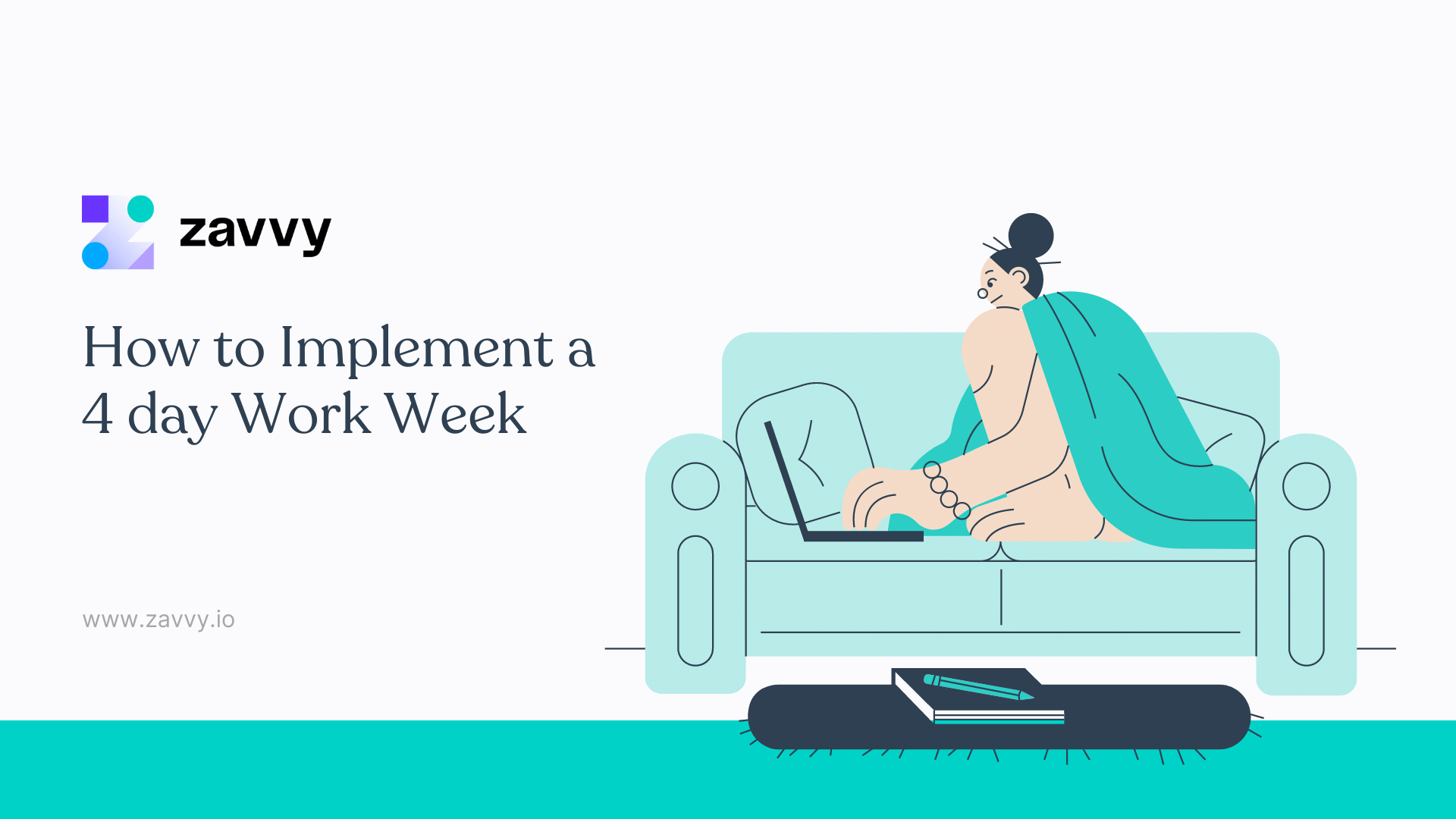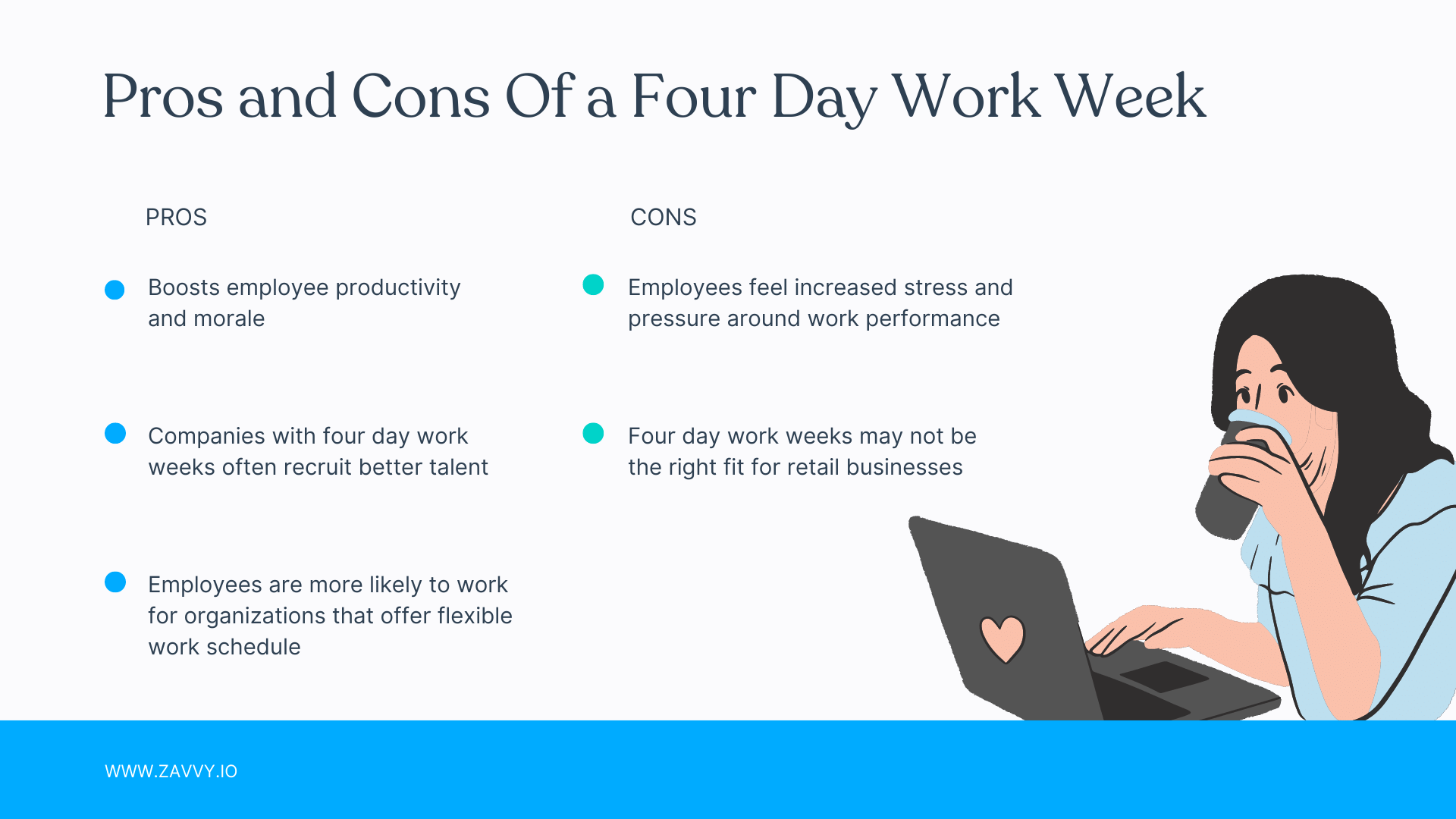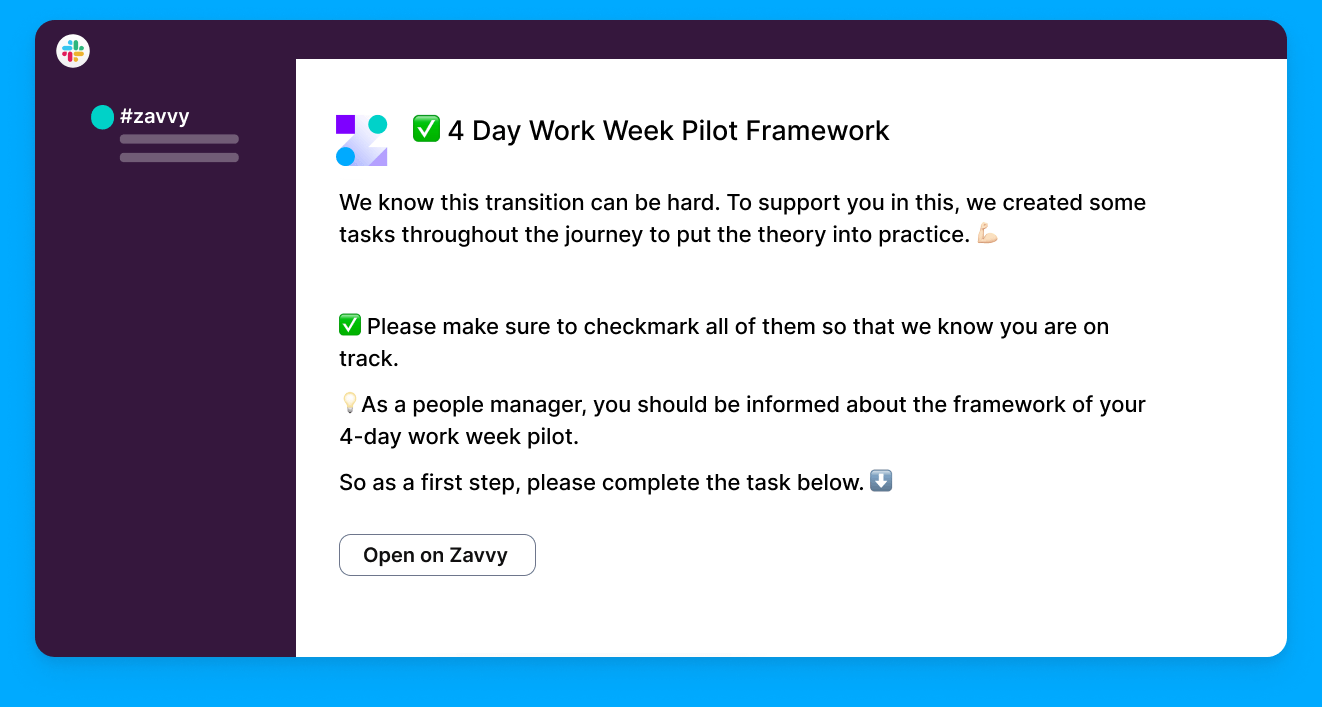
Berfu Ulusoy
Berfu is an Employee Experience Specialist at Zavvy. She has a background in learning psychology and helps our customers get the most out of their people enablement programs.


COVID-19 completely changed the global workforce. Where we once saw a standard Monday through Friday workweek, we're now seeing four-day workweeks, fully remote work, and unprecedented flexibility when it comes to working schedules.
Flexibility in the workplace is here to stay.
In fact, many employers have noticed an increase in productivity after introducing flexible schedules or remote/hybrid working options.
Four-day workweeks are becoming popular flexibility tools to improve morale and boost productivity to better meet work-life balance.
In a four-day workweek arrangement, employees reduce hours without getting a reduction in pay. Hours typically range from 32 to 36 hours per week across the workweek, meaning three-day weekends every week.
Not a bad setup if you're looking for enhanced work flexibility.
But, the 4-day workweek is one of the most drastic workplace changes a company can go through. And there's more to implementing it than sending a company-wide memo.
In essence, you'll need to re-onboard the entire company.
A few examples include:
So, how do you successfully implement the system across the entire organization?
Together with our curators, we have created a library of actionable digital marketing resources. Personalized to your team's needs.

According to Sloan Management Review, transitioning to a four-day workweek over a five-day one increases productivity and boosts employee morale. It makes sense - no reduction in pay, longer weekends, better work-life balance.
Studies have actually shown that in a traditional 40-hour workweek, employees are only productive for around 15 hours of the week.
When employees feel forced to stick to a traditional work schedule, productivity can drastically decrease. But interestingly, as the study shows, longer work days over fewer working days actually boosts productivity.
Companies with four-day workweeks often recruit better talent than their five-day workweek competitors.
The modern employee wants to see flexibility and a focus on employee experience. In a hot global talent market, smart employers should lean into providing flexibility in the workplace.
While there are plenty of obvious benefits to a four-day workweek, there are drawbacks to consider before making the transition.
After a four-day workweek trial in New Zealand, employees reported feeling increased stress and pressure around work performance. Work hours may have decreased, but the same amount of work is still there.
High volumes of work over fewer hours can easily lead to additional stress if the right implementation strategies aren't followed. These results indicate how important the right approach is.
Four-day work weeks may not be the right fit for every model. For example, retail businesses that require daily interactions with customers may not be able to adopt a four-day workweek, but that doesn't mean workplace flexibility isn't an option.
Major corporations and even entire countries have trialed four-day workweeks - and with much success.
While permanent adoption of four-day workweeks is still in the early stages for many employers, these studies are excellent examples of how a four-day workweek can benefit both the employees and the company.

Focusing on work-life balance and mental health, Buffer's CEO Joel Gascoigne announced a one-month trial in May 2020. And they haven't gone back ever since.
The initial trial was so successful that they extended the four-day workweek through the end of 2020. After hearing from employees and seeing an increase in productivity, the four-day workweek is now indefinite since the end of the year.

Microsoft employees in Japan experienced an unprecedented 40% boost in productivity after introducing a four-day workweek trial. Not only did productivity increase dramatically, but overall electricity costs dropped by nearly 25%.
The trial was active in the summer of 2019, and although it saw great success, there hasn't been much additional movement from Microsoft regarding further attempts or a permanent change.

Iceland (yes, the country) trialed a four-day workweek with nearly 3,000 workers from 2015 to 2019, well before the global COVID-19 pandemic.
Research showed that productivity either remained the same or even improved for most workers involved in the trial.
The trial involved moving to 35 or 36 hour workweeks across four days. Due to the experiment's success, over 80% of Iceland's workforce has either moved to a 4-day system without a reduction in pay or will do so in the future.
Other countries, such as Spain and the United Kingdom, have held trials with similar successes.
And Belgium introduced the right to a 4-day workweek by law in February 2022.
Implementing a four-day workweek is more than just sending a company-wide email. Change management is a structured, tailored approach to disseminating change throughout an organization.
Leveraging tools, consistent communication, and relationship-building, change management is a crucial skill that's often overlooked and undervalued.
It's tempting to just send an email introducing a positive change to your employees. Sending an email is fun, generates buzz, and gets your message out quickly.
Implementing a change as significant and impactful as a four-day workweek takes time and careful consideration to implement successfully.
Think through an impactful communications campaign for your team, whether that's in-person communications, a series of emails and memos, or a personalized change journey through Zavvy.
We are helping our customers do exactly that. And in the following chapters, we're sharing the exact process.
Moving to a four-day workweek in your company is really a shift in the definition of success. Teams that are strictly aligned to a traditional 40-hour workweek are often focused on the visible input of the team.
That means the priority is ensuring everyone is logging their 40 hours and being physically present to complete their tasks.
Sound familiar?
Outcome-based thinking is a dramatic shift in how work is seen and lends flexibility, work-life balance, and overall increased satisfaction from employees.
Outcome-based work rather focuses on clearly defining goals and objectives and allowing employees to achieve those goals in the way that works best for them.
Rather than focusing on a minimum number of hours or being physically present in an office to complete tasks and assignments, outcome-based work puts trust and ownership back into the hands of your most valuable asset - your people. See the difference?
Transitioning to a four-day workweek means transitioning to an outcome-based model of work.
Management from the top down will need to embrace outcome-based work for a four-day workweek to succeed.
Trust your employees to get their tasks done in ways that work best for them.
Here are a few tips for your people managers to master the change
👉 Set clear metrics for your teams
There’s no room for ambiguity in an outcome-based work culture; moving the goalposts or changing the requirements can hurt the overall aim of this approach which is to facilitate freedom and creative problem-solving within a firm framework.
Encourage people managers to strive to accurately and efficiently measure results and set specific and clearly defined metrics for your team.
👉 Trust brings the best outcomes
Trust that your team members love their jobs and do the work.
Progress updates can be baked into regular one-to-one meetings, where they can update you on their progress and share plans with you.
It does not have a place in this outcome-based work culture. You cannot give independence, responsibility, and autonomy to your team members while continuing to loiter over their shoulders.
👉 Do your team members have the right skills to achieve the outcomes you’ve set?
Take a look at the most needed skills and communicate these expectations openly. Before your 1:1 session, try to think of a training for each skill
👉 Remember that people are humans first and employees second.
Having empathy in communication allows for employees to be heard, feel appreciated, and overall, be more productive.
Lead with empathy and try to really understand who your people are and what they need—step into your colleague’s shoes and understand that life comes up.
Although this particular culture values autonomy, your direct reports still need to feel they can come to you with problems and queries. Make yourself available for your team members.
With fewer working days (and often fewer working hours), maximizing your team's time is essential.
👉 Meetings should add value, not waste time.
It's too often that we come out of an hour-long meeting thinking the content could have been condensed to a single email.
It may be best to implement a standard policy for meetings.
For example, require meetings to be 30 minutes or less or designate set days and times where no meetings are allowed. Have clear, structured agendas to guide the conversation and establish goals for each and every meeting.
Before a meeting, ask yourself
👉 A clear agenda helps be more efficient and understand if the meeting is relevant at all.
A facilitator is the person who guides the meeting, helps keep the participants on track, stops circular discussions, makes sure the meeting ends with clear outcomes and next steps, and keeps an eye on the time.
👉 Avoid discussions spiraling out of control
Allocate a certain time for each activity on your agenda, and stick to this schedule.
This approach forces you and the team to think more efficiently, and cut out circular discussions.
The time-slots for each activity should always feel a little bit too tight so that your brain goes straight into solution-mode, instead of idling around. Don´t waste your team´s energy
👉 Avoid groupthink, idea contamination, and group biases
This means, you’re collaborating on the same problem in real-time, but instead of discussing ideas openly or brainstorming, you’re silently noting them down on a sticky note (e.g. on a Miroboard).
So, instead of kicking off the solution search with an open discussion, give the team some sticky notes, set a timer, and ask them to note their ideas down and discuss them afterward if needed. This technique also gives introverts and more junior members of the team the possibility to share their ideas freely.
👉 Define clear outcomes
Leave the last few minutes of every meeting to discuss the next steps. Even if you can’t come to the final conclusion, there should be clear next steps defined after the meeting is done.
💡Some effective meeting strategies to help ensure that people leave your meeting with clarity and purpose:
👉 Maximize friction with transparency
Meeting minutes are a tangible record of the meeting for its participants and a source of information for members who were unable to attend.
They should be accessible for every team member (use tools such as google docs, Asana, Miro etc.) and capture the essence of the meeting, including details such as:
👉 Establish clear schedules and flexibility within the team.
Setting the right expectations up front about working days and hours, individual schedules, and procedures for adjusting schedules will set the entire team up for success.
Flexibility is important, but it's also important to have clear, up front communication about any changes to existing schedules.
👉 Encourage upward feedback along the process
Schedule feedback surveys at different milestones of your project implementation
Pulse surveys are one way to do so over time. However, we recommend at least in the beginning adding 2-3 dedicated questions.
👉 Make team retros a priority
Retros are most effective at the end of implementing a new process or procedure.
Retros are powerful tools for collecting feedback, improving processes, and fostering positive communication with employees.
Consider hosting a retro session immediately after implementation to get feedback on how the transition was received, as well as multiple sessions post-implementation to get feedback on how the four-day workweek is going.
If you're looking for inspiration to change it up a little, here are 10 ideas from Miro.
Implementing a four-day workweek means re-onboarding the entire company.
You need tactical change management, a communication plan, and practical guidance for everyone - especially people managers.
Here's how Zavvy can help:

Create a fully custom microlearning journey with a pre-built template. Make content creation a breeze and focus on implementing positive changes in your business with Zavvy's intuitive manager training platform.
Curious how it works? Get a free consultation with our employee experience specialists!
A four-day workweek is a fairly straightforward work flexibility concept. Rather than working a standard 40-hour workweek across five working days, employees work fewer hours (typically 32 to 36 hours per week) across four working days.
Employees get a three-day weekend every week. Studies have shown that four-day workweeks lead to increased productivity, improved employee morale, and an overall better work experience for both employees and employers.
In most four-day workweek arrangements, employees do work fewer hours without a reduction in pay.
Employees are not productive all 40 hours per week, meaning there is often an opportunity to reduce the number of working hours in a week without impacting productivity.
However, there are some companies and industries that are not able to reduce working hours when moving to a four-day workweek.
For example, roles that require direct interaction with external customers may not be able to reduce working hours but may move to a four-day workweek.
In many four-day workweek trials around the world, the evidence is overwhelming. Not only is there virtually no negative impact to productivity, it's actually to common to see an increase in productivity when implementing a four-day workweek.
Upskill your team every week with the best contents and personalized recommendations.

COVID-19 completely changed the global workforce. Where we once saw a standard Monday through Friday workweek, we're now seeing four-day workweeks, fully remote work, and unprecedented flexibility when it comes to working schedules.
Flexibility in the workplace is here to stay.
In fact, many employers have noticed an increase in productivity after introducing flexible schedules or remote/hybrid working options.
Four-day workweeks are becoming popular flexibility tools to improve morale and boost productivity to better meet work-life balance.
In a four-day workweek arrangement, employees reduce hours without getting a reduction in pay. Hours typically range from 32 to 36 hours per week across the workweek, meaning three-day weekends every week.
Not a bad setup if you're looking for enhanced work flexibility.
But, the 4-day workweek is one of the most drastic workplace changes a company can go through. And there's more to implementing it than sending a company-wide memo.
In essence, you'll need to re-onboard the entire company.
A few examples include:
So, how do you successfully implement the system across the entire organization?
Get a demo!
We'll be happy to show you around and answer all your questions.
Trusted by innovative companies



We'll be happy to show you around, answer your questions, or arrange a free trial.
Erhalten Sie eine kostenlose Demo unserer Onboarding-Software.
Vertraut von



Your Training & Development Strategy - Solved in 1 Tool.
Trusted by innovative companies



We'll be happy to show you around, answer your questions, or arrange a free trial.
Learn how Zavvy helps you drive performance, development, and engagement.
Trusted by innovative companies



We'll be happy to show you around, answer your questions, or arrange a free trial.
We'll be happy to show you around and answer all your questions.
Trusted by innovative companies



We'll be happy to show you around, answer your questions, or arrange a free trial.
Gerne zeigen wir Ihnen ganz unverbindlich unsere Plattform im Detail.
Vertraut von modernen Unternehmen



Get a demo!
We'll be happy to show you around and answer all your questions.
Trusted by innovative companies



We'll be happy to show you around, answer your questions, or arrange a free trial.
Erhalten Sie eine kostenlose Demo unserer Software für Mitarbeiterenwicklung und Training.
Moderne Unternehmen
setzen auf Zavvy


